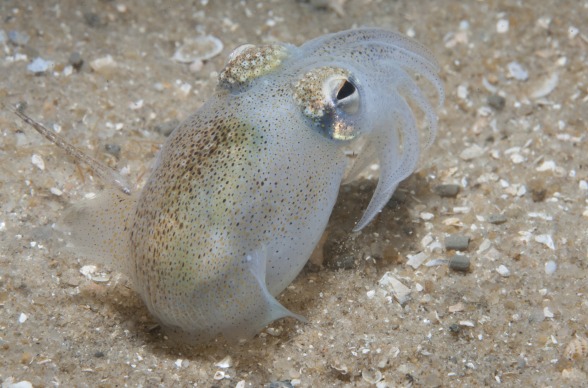
Updated at 9:21 a.m. ET.
Sometimes, gifts get put to surprising uses.
And scientists have found possibly one of the wackiest: The female southern bottletail squid will eat packages of sperm that males passed to them to fertilize eggs.
The study, published today (June 4) in the journal Biology Letters, found that during mating, a male places a sperm package into the cavity that contains the female's mouth. Most of the time, the sperm becomes a tasty snack for the female.
"The females are using the nutrients to grow her unfertilized eggs," said study co-author Benjamin Wegener, an evolutionary biologist at Monash University in Australia. "That means that males could be contributing to the growth of her eggs and possibly helping the next male that comes along but not actually getting any benefit out of itself." [10 Tantalizing Tales of Sex in the Animal Kingdom]
Ubiquitous creature
Little is known about the mysterious southern bottletail squid, Sepiadarium austrinum. The translucent, inconspicuous creatures, which grow up to 2 inches (5 centimeters) long, live along the southern coast of Australia.
Sign up for the Live Science daily newsletter now
Get the world’s most fascinating discoveries delivered straight to your inbox.
Wegener was collecting another rare species in Australian waters when he noticed the squid were incredibly common. Intrigued, he collected some of the cephalopods and placed them in a tank in his lab.
"They just went at it straight away," Wegener told LiveScience.
Because the creatures are almost completely see-through, Wegener was able to see exactly what happened during the two or three minutes of mating.
The males aim dozens of spermatophores, banana-shaped packages that carry spring-loaded squid sperm inside, toward the females' buccal cavity, which contains their beaklike mouths.
In theory, once inside the female, the spermatophore turns inside out to release the sperm and cements onto the wall of the buccal cavity. The female squid then places an unfertilized egg on the sperm.
But most of the time, the sperm never makes it that far. Instead, female squid gobbled up the spermatophores that landed within swallowing distance of their mouths.
"You can see the beak scraping away at the spermatophores, and you can see them swallowing," Wegener told LiveScience. "Every single time I watched, they swallowed."
The females must have used at least some of the sperm to make babies, because they laid fertilized eggs a few weeks later.
"There seems to be areas of prime real estate that the male can position his spermatophores in that the female can't get to," Wegener said. "But his aim isn't really that fantastic. I think he gives it a shot and hopes for the best."
And it's possible that the female may also play a role in altering the odds.
"I wouldn't be surprised if the female influences where it positions by influencing where she positions her beak," he said of the spermatophores.
Sexual selection
The behavior reveals sexual selection.
For females, there are several potential benefits. Insects have long been known to snack on sperm for its nutritional boost, and in other species, females eat ejaculate to assess the quality of potential mates, Wegener said.
For males, it's not clear that sperm eating benefits them at all.
One possibility is that male squid provide excess spermatophores to provide nutrition for their young. But when the research team tagged chemicals in the spermatophores to track their fate, they found the nutrition went to the females and unfertilized eggs, not a specific squid's young, Tom Tregenza, an evolutionary ecologist at the University of Exeter in the UK, wrote in an email. Tregenza was not involved in the study.
"More likely there is a conflict between males and females where it would be better for each male if his sperm packet wasn't eaten, but ultimately in cephalopods the female is in charge and she can decide what is best for her and her offspring," Tregenza wrote. "As the authors point out, she might even choose to eat the sperm packets from less attractive males and use the sperm from more attractive ones for fertilizing her eggs."
Editor's Note: This article has been updated to correct the size of the squid. The southern bottletail squid grows up to 2 inches, not 5 inches, long.
Follow Tia Ghose on Twitter and Google+. Follow LiveScience @livescience, Facebook & Google+. Original article on LiveScience.com.

Tia is the managing editor and was previously a senior writer for Live Science. Her work has appeared in Scientific American, Wired.com and other outlets. She holds a master's degree in bioengineering from the University of Washington, a graduate certificate in science writing from UC Santa Cruz and a bachelor's degree in mechanical engineering from the University of Texas at Austin. Tia was part of a team at the Milwaukee Journal Sentinel that published the Empty Cradles series on preterm births, which won multiple awards, including the 2012 Casey Medal for Meritorious Journalism.










